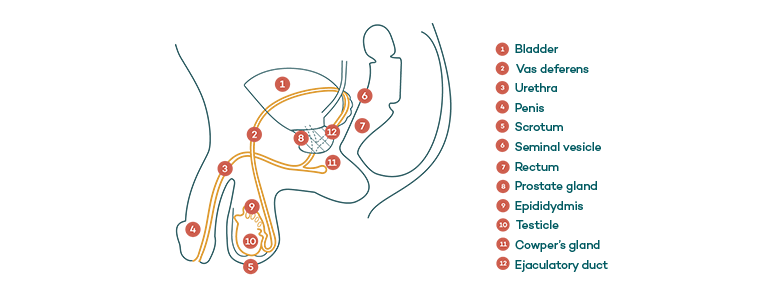Scrotal lumps
More resources
Lumps in the scrotum
The are a few different lumps and bumps that can appear in or on your scrotum.
Just like for any other part of your body, if you experience testicular pain or you notice anything unusual about the appearance of your scrotum or what’s inside it, you should make an appointment to see your doctor.
For information about different types of lumps and bumps in or on your scrotum, visit:
- Hydrocele
- Varicocele
- Epididymitis
- Orchitis
- Testicular cancer
- Testicular torsion
- Genital warts
- Molluscum contagiosum
Most lumps found in the scrotum aren’t cancer. Cysts on the scrotum filled with fluid are very common, especially as you get older. Varicose veins within the scrotum are also common.

Hydroceles
What is a hydrocele?
A hydrocele is a swelling in the scrotum caused by a buildup of fluid around one or both of your testes.
Hydroceles are usually painless, but they can increase in size and get very large. Hydroceles are not dangerous but they can get in the way or become uncomfortable if get big enough.
Hydroceles are usually a consequence of how your body developed before birth, especially when they occur in babies and young boys. In older males, hydroceles can be caused by injury, infection or inflammation. Very rarely, hydroceles can be a sign of testicular cancer in young men.
What treatments are there for hydroceles?
Hydroceles can be cured by a minor operation.
Varicoceles
What is a varicocele?
A varicocele occurs when the veins in the scrotum that drain blood from the testis (testicle) become abnormally dilated and large. Varicoceles may look or feel like ‘a bag of worms’ within the scrotum.
Varicoceles become increasingly common with age and usually happen on the left side of the scrotum. They can sometimes cause pain but usually, there are no symptoms.
Varicoceles are commonly found in men who have fertility problems, and surgery to fix the varicocele improves fertility in some of these men.
What treatments are there for varicoceles?
There are several surgical procedures that can be used to treat a varicocele, but treatment is not always necessary.
Learn more about varicoceles here.
Epididymal cyst
What is an epididymal cyst?
Epididymal cysts are very common and can happen at any age. They’re small collections of fluid within the epididymis (the thin, coiled tube that transports sperm from the testis).
Usually, epididymal cysts feel like a pea-sized lump at the top of the testicle, but they can become larger.
An experienced doctor can usually diagnose an epididymal cyst with a genital examination. If there is any doubt, the best test is an ultrasound scan.
Epididymal cysts aren’t dangerous, and they don’t mean you have a higher chance of cancer, infertility or any other problem. Usually, they go away by themselves. If they get larger, they can cause bother or discomfort.
What treatments are there for epididymal cysts?
Epididymal cysts are usually only treated if they are causing pain or discomfort.
Epididymal cysts can be drained using a needle, under local anaesthetic, but the fluid often comes back. Draining the fluid and then injecting something to close up the space in the cyst usually cures them.
Epididymitis
What is epididymitis?
Epididymitis is a painful swelling or inflammation of the epididymis – the thin, coiled tube found behind each testicle. Epididymitis is one of the most common causes of pain in the scrotum. It can be difficult to tell if the pain and swelling are coming from your epididymis, your testicle, or both. You might have pain when urinating, not be able to hold on, or need to urinate urgently or often. Epididymitis can also cause a discharge from the penis, or fever.
Epididymitis is caused by infection, irritation or injury of the epididymitis. In younger men, epididymitis usually occurs in association with a sexually transmitted infection. In older men, infections by bacteria from the gastrointestinal tract are more common causes of epididymitis. If you have not yet engaged in sexual activity, the most likely cause of epididymitis is repetitive irritation of the epididymis during physical activity.
What treatments are there for epididymitis?
Epididymitis is usually treated with antibiotics. Your doctor might start you on them straight away, but you might need to change the type of antibiotic depending on your test results.
Learn more about epididymitis here.
Orchitis
What is orchitis?
Orchitis is an inflammation of one or both testicles that causes testicular pain, swelling and redness.
Orchitis is usually accompanied by inflammation of the epididymis (epididymo-orchitis). Epididymo-orchitis is a common cause of pain and swelling in the scrotum.
The mumps virus is a common cause of orchitis but it can be caused by other viruses and bacteria. Mumps can damage your ability to produce sperm, especially if you get it after the age of eight.
What treatments are there for orchitis?
The usual treatment for orchitis is pain relief and rest. If you have a bacterial infection, your doctor will probably prescribe antibiotics.
Learn more about orchitis here.
Testicular torsion
What is testicular torsion (twisting)?
Testicular torsion is a twisting of the spermatic cord within the scrotum that reduces or completely stops blood flow to the testicle. Testicular torsion is a medical emergency and requires immediate treatment – the longer it’s left untreated, the greater the risk of irreversible damage to the testis.
Testicular torsion causes severe pain, usually in the scrotum, that starts suddenly. In many cases, it causes pain in the abdomen, and nausea and vomiting. You might notice the affected testicle in a different position or higher in the scrotum than normal. It’s usually slightly swollen and sore to touch.
Sometimes testicular torsion occurs because the testicle is not securely attached to the wall of the scrotum, making it more likely to twist and block the blood supply. It can also be caused by vigorous activity or injury.
What treatments are there for testicular torsion?
If you have sudden onset pain in the scrotum, seek medical help immediately. Testicular torsion requires immediate surgery to correct the problem.
Learn more about testicular torsion here.
Genital warts
What are genital warts?
Genital warts usually appear as one or a group of small, raised bumps on the scrotum, on the shaft or tip of the penis, and in or around the anus. Genital warts range in colour and size and may be rounded or flat, smooth or rough. They don't usually don’t cause any additional symptoms, but they can itch in some people. Genital warts are easily between people through skin-to-skin contact.
What is the treatment for genital warts?
Genital warts can be frozen, ‘burned’ or cut off by your doctor. There are some medications that can be applied directly to warts that may help them go away.
Genital warts are caused by human papillomavirus and there is a vaccine available to prevent infection by the types of human papillomavirus most associated with disease in humans. The vaccination doesn’t treat an existing infection, so it must be given before you’re exposed to the virus to be effective.
In Australia, the vaccination is available free as part of the National Immunisation Program and is recommended for:
- All adolescents aged 9–18 years
- People with poor immune function
- Men who have sex with men
Learn more about genital warts here.
Molluscum contagiosum
What is molluscum contagiosum?
Molluscum contagiosum is a skin condition caused by the molluscum contagiosum virus, which usually results in a collection of up to 30 small (2-5 mm) dome-shaped bumps on the skin. The bumps can be pale white or have a yellow or pink colour and have a ‘dimple’ or ‘pit’ in the middle.
What is the treatment of molluscum contagiosum?
Molluscum contagiosum will go away on its own, but it takes about 6-12 months. Molluscum contagiosum spots can be frozen, ‘burned’ or cut off by your doctor, but these treatments are painful and spots can reappear, requiring more than one treatment.
Learn more about molluscum contagiosum here.
Questions to ask your doctor
Things to think about before your appointment
-
When did you notice any swelling or lumps on your scrotum?
-
Are you experiencing any discomfort/pain in the scrotum or testicles?
-
If you have a lump, is it changing in size?
-
Did you have undescended testicles as an infant?







